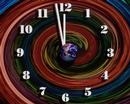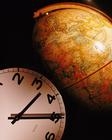
| One question that everyone asks nowadays with hardly a thought is `What's the time?'. Yet only 150 years ago this was a very difficult question to answer. Each town had its own clock and kept its own time. There was no set convention on how to measure time, when a day began or ended or even how long an hour was! |  |
 | In the middle of the 19th century however, communications such as railways, telegraph and international shipping expanded greatly and so the need was recognised for some internationally agreed standards for measuring time around the world. If you know it's 12 noon at one particular place or line on the Earth then you know the time everywhere else in the world by knowing how far away from that line you are. The line from the North Pole to the South Pole from which all time is measured is called the Prime Meridian. |
| A conference held in Washington DC in 1884 decided that Greenwich would be place from which all other time would be measured. So the Prime Meridian runs through the North Pole, the South Pole and Greenwich. Why Greenwich? Firstly, the US had already based its time-zones on measuring from Greenwich and secondly, most of the world's commerce depended on sea charts which used Greenwich as the Prime Meridian. |  |
Use the browser's BACK button
to return to the previous page.